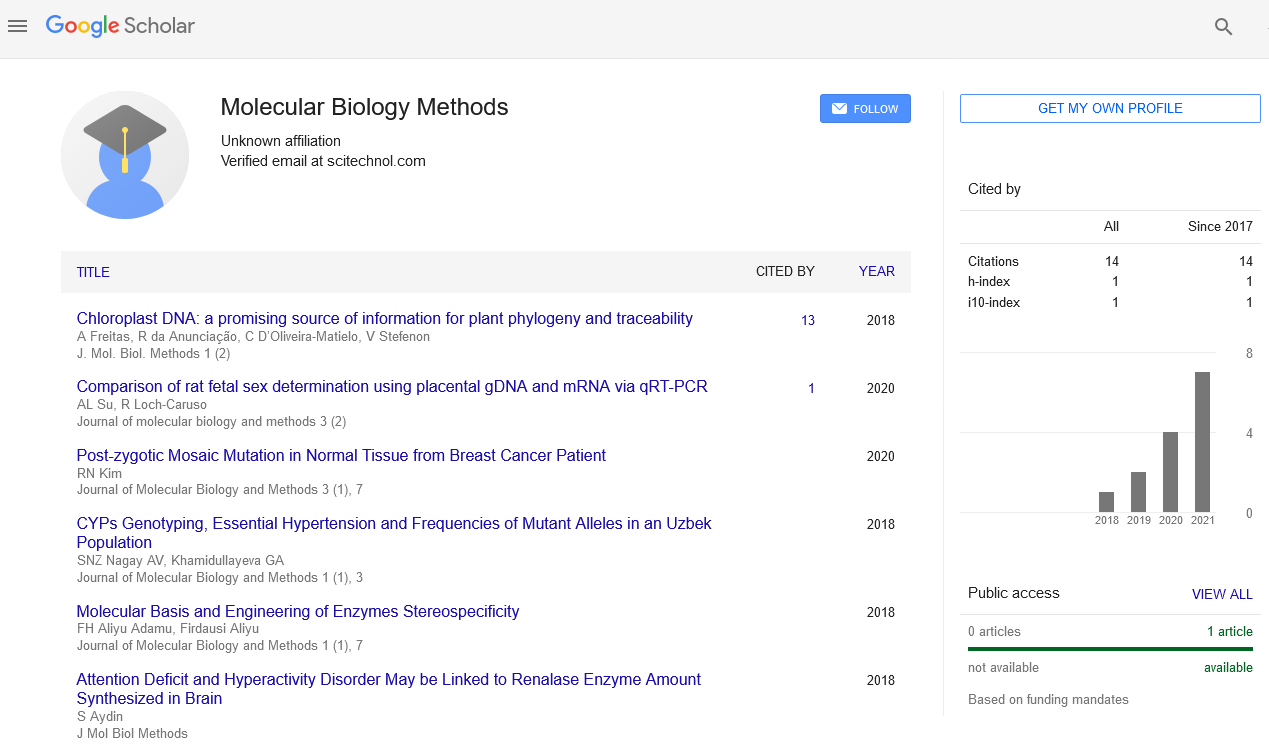Commentary, J Mol Biol Methods Vol: 6 Issue: 2
Genomic and Metabolomic Interplay in Exploring Microbial Communities of Extreme Environments
Mei Lena*
1Department of Evolutionary Genetics, Max Planck Institute for Evolutionary Anthropology, Leipzig, Germany
*Corresponding Author: Mei Lena,
Department of Evolutionary Genetics, Max
Planck Institute for Evolutionary Anthropology, Leipzig, Germany
E-mail: kyriacou2@yahoo.com
Received date: 22 May, 2023, Manuscript No. JMBM-23-108102
Editor assigned date: 26 May, 2023, Pre QC No. JMBM-23-108102 (PQ);
Reviewed date: 10 June, 2023, QC No. JMBM-23-108102;
Revised date: 19 June, 2023, Manuscript No: JMBM-23-108102(R);
Published date: 28 June, 2023, DOI: 10.35248/jmbm.100138
Citation: Lena M (2023) Genomic and Metabolomic Interplay in Exploring Microbial Communities of Extreme Environments. J Mol Biol Methods 6:2.
Description
Metagenomics and metabolomics are powerful tools that have revolutionized the study of microbial communities in extreme environments. These environments, such as deep-sea hydrothermal vents, acidic hot springs, Polar Regions, and hypersaline lakes, pose significant challenges for life due to their extreme conditions. Yet, they also harbor unique and diverse microbial communities that have adapted to survive and thrive in such extreme settings. Integrating metagenomics and metabolomics provides a comprehensive approach to characterizing these microbial communities, offering insights into their functional capabilities and ecological roles. Metagenomics is the study of genetic material recovered directly from environmental samples, bypassing the need for cultivation. This technique involves extracting DNA or RNA from a sample, followed by high-throughput sequencing to generate vast amounts of sequence data. By analyzing these sequences, researchers can identify the microbial species present in the community, infer their potential functions, and study their genetic diversity and interactions. On the other hand, metabolomics focuses on the study of small molecules called metabolites within a biological system. Metabolites are the end products of cellular processes and provide a snapshot of the biochemical activity within the microbial community. Mass spectrometry and nuclear magnetic resonance spectroscopy are commonly used techniques to identify and quantify metabolites in a sample. Metagenomics provides information about the genetic potential of the microbial community, while metabolomics reveals the actual biochemical activities taking place. Integrating these datasets enables researchers to connect the genetic makeup of the community with its functional capabilities, shedding light on the metabolic pathways and processes that are active in the extreme environment.
Extreme environments often house unique and unexplored microbial life. By combining metagenomic and metabolomic data, researchers can identify novel metabolic pathways and enzymes that may have biotechnological or industrial applications. Microbial communities in extreme environments often depend on intricate interactions among different species for survival. Integrating metagenomic and metabolomic data can help elucidate the network of interactions and cooperation among microorganisms in these environments. Extreme environments are sensitive to environmental changes and human impacts. The integration of metagenomic and metabolomic data allows for the development of biomarkers to monitor the health and stability of these ecosystems. Extreme environments are a treasure trove of potentially valuable biocompounds and biomolecules.
Integrative analysis of metagenomic and metabolomic data can aid in bio prospecting efforts, leading to the discovery of novel natural products with pharmaceutical or industrial applications. Extreme environments are natural laboratories for studying microbial adaptation and evolution. The integration of metagenomic and metabolomic data provides a comprehensive view of how these microbial communities have evolved to withstand harsh conditions over time. However, integrating metagenomics and metabolomics data also presents some challenges. The vast amount of data generated from both approaches requires sophisticated bioinformatics tools and computational resources for analysis. Additionally, standardizing methodologies and data formats across different studies is essential to facilitate data sharing and comparison.
In conclusion, the integration of metagenomics and metabolomics is a powerful approach for characterizing microbial communities in extreme environments. It provides a deeper understanding of their functional capacities, metabolic pathways, and interactions, which has implications for various fields, including environmental science, biotechnology, and astrobiology. As technology and methodologies continue to advance, this integrative approach will undoubtedly play a crucial role in unlocking the mysteries of microbial life in extreme environments.
 Spanish
Spanish  Chinese
Chinese  Russian
Russian  German
German  French
French  Japanese
Japanese  Portuguese
Portuguese  Hindi
Hindi 